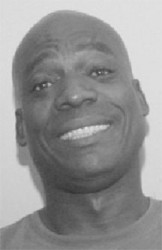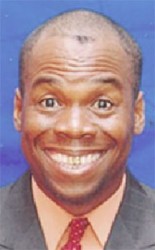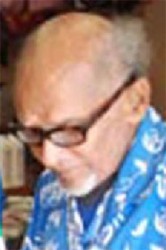Comedy is hard work. It is also very deceptive. The current success that it enjoys on the Guyanese stage, and the apparent lightheartedness of it all, the fun, the hilarity, the shooting nonsense to make people laugh, deceives everyone into believing that it is easy. However, many pretenders to the throne in this art form soon confront the reality that it is not all play. As has been stated before, it soon hits them that comedy is serious business. And that is a fitting irony.
Much of this came into focus again with the recent staging of Uncensored 5, produced by Lyndon Jones and Maria Benschop. This annual show has earned a high place as the foremost event in stand-up comedy with overwhelming box office pull.
Stand-up comedy now holds centre stage, and is the form of theatre most likely to fill the auditorium. It is popular theatre with compelling mass appeal, but it is not as simple as that might suggest. There are different forms of comic performance, and stand-up comedy is just one. Many actors, and of course, audiences, are drawn to it because of the high entertainment and the apparent naturalness of laughter. However, the form of theatre known as comedy is not always fully understood, and the same goes for the demands of various forms of comic performance from high farce to slapstick. As it is at the moment, in addition to talent, stand-up comedy calls for a good deal of courage, performance skills, the building of material, and intellectual work, including an understanding of the audience. Some who attempt it have limited success because they hardly get beyond the telling of jokes.
 Comedy and comic performance have a long history and belong to very strong traditions in both the formal stages of Western theatre and the many forms of popular and traditional theatre. Classical drama had its comedies which took social commentary very seriously and produced satires which set the tone for this art form over the centuries. This Greek formula has been very influential, and saw strong rebirth in the Elizabethan drama. Shakespeare surpassed his peers in that era, exerting his superior innovation to turn the classical into the Shakespearean comedy. But like his contemporaries, the Bard of Avon understood the Elizabethan audience well, creating comic performance with them in mind. Even the fearful tragedies have famous interludes of what became known as ‘comic relief’ and other sequences of humorous and often racy banter. Shakespeare might have been the best, but he was not alone in this, as is evident in the work of Christopher Marlowe and Ben Jonson, and even lesser lights like Thomas Dekkar.
Comedy and comic performance have a long history and belong to very strong traditions in both the formal stages of Western theatre and the many forms of popular and traditional theatre. Classical drama had its comedies which took social commentary very seriously and produced satires which set the tone for this art form over the centuries. This Greek formula has been very influential, and saw strong rebirth in the Elizabethan drama. Shakespeare surpassed his peers in that era, exerting his superior innovation to turn the classical into the Shakespearean comedy. But like his contemporaries, the Bard of Avon understood the Elizabethan audience well, creating comic performance with them in mind. Even the fearful tragedies have famous interludes of what became known as ‘comic relief’ and other sequences of humorous and often racy banter. Shakespeare might have been the best, but he was not alone in this, as is evident in the work of Christopher Marlowe and Ben Jonson, and even lesser lights like Thomas Dekkar.

Other comic traditions developed in the Middle Ages and the early Renaissance, notably when drama moved out of the church and became popular. Widespread traditions developed in Europe around the Italian Commedia Dell’arte with a cast of comic stock characters such as Harlequin, Pierrot, Colombina and Pantaloon. One of the most popular forms of theatre – slapstick – developed out of these forms of drama. They also influenced similar development in England with the pantomime in particular. The strong links between this theatre and religion continued as audiences delighted in seeing devils on stage tearing and dragging errant Christians off to hell.
The ancient roots of comic performance may also be seen in the tradition of the court jester whose job it was to amuse the king. They provided comic relief, but a comic character who developed out of this was the ‘Fool’ whose function was more serious. As reflected in Shakespeare’s plays (King Lear, for example), the Fool had licence to criticize the king and show him where he was guilty of folly. Here was an archetype of the serious business of comedy, where satire and social commentary are concerned. In these may be found important roots to one of the functions of stand-up comedy – social criticism.
Similarly, some of the characters and types of comic performance described above contained characteristics of stand-up comedy because the performers had to stand and deliver to a sometimes difficult audience. Shakespeare’s clowns engaged the audience, sometimes directly, and sometimes with sexual innuendos (take the porter in Macbeth, for example), a trend that continued forever in stand-up comedy. Similarly, Harlequin was known to take on his audience. Dickens in one scene in Great Expectations describes rowdy members of the audience heckling the actors on stage who had to be able to take them on.
Outside of Europe, the satirical tradition is an extremely powerful one in traditional theatre. It is contained in many African forms, including those with religious and social functions and the types of plays that developed. Sexual references which are the staple diet in stand-up comedy in Guyana today, abound in the African theatre traditions (speaking specifically of West and East Africa). In many cases, however, they are not for gratuitous entertainment, but are often functional in social or even spiritual meaning. Those functions, however, no longer obtain in the African forms that were transplanted in Guyana, and in contemporary performance it is just plain popular fun. It is the favourite topic of stand-up comedians because it is the audience favourite, and nothing fires them up more than the mention of sex.

Yet, even that popular subject is a part of tradition. Caribbean vaudeville and the calypso, have the humour of the double entendre at their core. This vaudeville flourished in the first half of the twentieth century. It is often said that it evolved from the British music halls. However, while no attempt will be made to deny any such connection (so many Caribbean traditional theatrical forms have British influence) there are direct and fundamental indigenous and African roots. Stand-up comedy grew up and flourished in vaudeville. Most of the famous Caribbean comedians of the past emerged from that background. These include Ranny Williams, Bim and Bam, Louise Bennett of Jamaica and Sam Chase and Jack Mello as well as Habeeb Khan of Guyana.
It is interesting that while comedians like Bim and Bam and Habeeb Khan were in the mould of the risqué type humour, Williams and Bennett who teamed up as Lou and Rannie, were not. They targeted a general audience in the Christmas Morning Concerts on radio and concentrated on situational comedy. Similarly, some currently popular comedians who inherited that tradition such as Bello and Blacka have a repertoire that includes but is not steeped in racy humour. Owen ‘Blacka’ Ellis is now a solo act, but rose out of the Bello and Blacka duo who did many social and political commentaries.
It is from that tradition that shows such as Uncensored descended. Contemporary Guyanese comedians have struggled for a long time to reach the level that they currently enjoy. For many years Habeeb Khan (a legend who does not perform now at his riotous best) stood alone as a Guyanese comedian of class. But Uncensored has solidified and become a class act for stand-up comedy. Producer Maria Benschop, with a sensible attitude, has developed a very long way since her fledgling efforts to attain this level. The show has come of age along with the now leading Guyanese comedians Lyndon Jumbie Jones (who is also an impresario) and Henry Rodney. This is a considerable development from Osafa George’s Upscale Restaurant where Jones learnt the trade and Rodney matured.
They are now joined by another generation of bright prospects including Leza Radika Singh, Minerva Austin, Odessa Primus, Kwasi Edmondson and Mark Kazim. However, much as it showcased them, Uncensored 5 was an indication that most of the contenders need a renewal. They dropped in quality from where they were in 2012 and 2011, and this was especially the case for Kerwin ‘Sir’ Mars and ‘Chubby’ Williams.
The Guyanese comedians need to work. A stand-up comedy routine demands preparation and the building of a considerable repertoire. The stand-up comic must have a store of material at his fingertips that exceed what he will use in any one performance. It is hard and embarrassing to run out of material and out of ideas while on stage. Most of those on show made a much better impression when they adopted a dramatic persona through whose character and world view they

delivered the routine.
This is a particular strength of Leza Singh. It is not compulsory, but it works. Basically they made a deeper impression when the jokes were anecdotal or arose from a theme.
The different kinds of comic theatre hold relevance here, and there is great doubt whether some performers understand the differences. Camp and low farce tend to be shallow – they may get a roar from the audience the first time or even the first repetition. But audiences tire of repeated farcical gimmicks; the forte of the stand-up comic is wit – verbal dexterity rather than slapstick. Quite in evidence too in this year’s performance was perhaps a bit of inexperience or insufficient thoroughness. A comedian should avoid asking the audience questions to which he does not know the answer. If he throws questions at the audience he must have the answers already worked out, or he must have engineered only one obvious answer, otherwise the audience might surprise and even embarrass him when they throw back an answer he did not expect or does not want.
Similarly, unless he has the command, the confidence, and the audience eating out of his hand, he should not ask them to assess or approve him – they might surprise and embarrass him. Kwasi Edmondson had the courage and boldness to get away with that. He can, with some work, use his skill as a dancehall type entertainer with lyrics and song to create a worthy routine. Another part of the Caribbean comedy and satirical tradition is picong which includes audience engagement. Jones is a master of that, as is Rodney, and the lesser lights need to acquire that.
Uncensored with its annual competition has contributed significantly to the development of the second line of stand-up comedians, building upon the amateur nights at Upscale. But from the evidence at the end of 2013 most of them have slackened and seemed short of work. They need more thorough preparation, ideas and consistency to remain in the company of serious comedy professionals.









